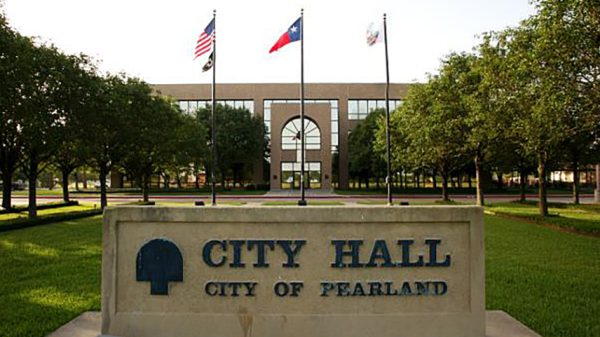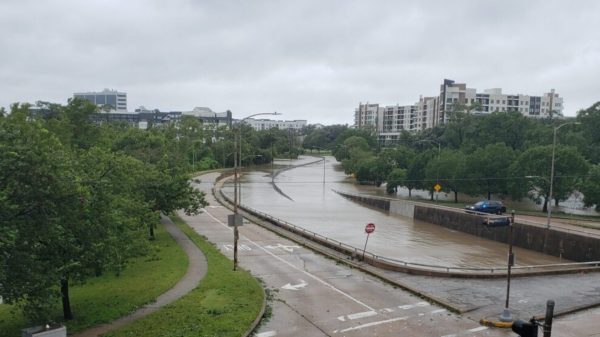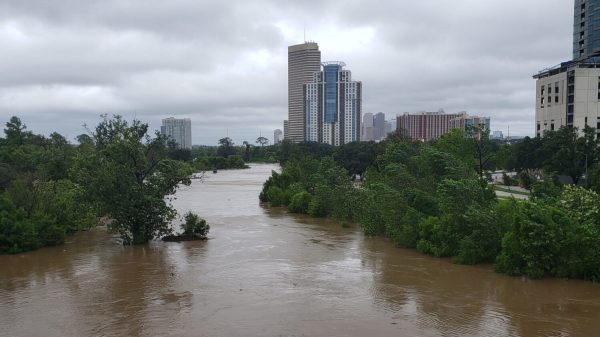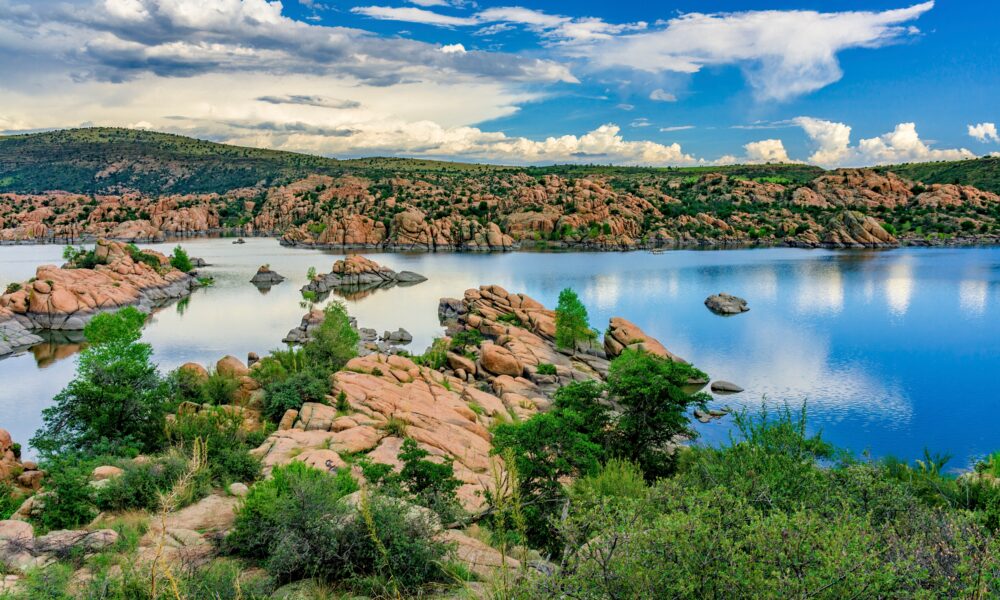
Watson Lake in Prescott, Arizona
Watson Lake looks like a total dream spot: a blue oasis winding through massive granite boulders just outside Prescott.
You can kayak through the rock maze or hit the trails for killer views, but here’s the catch: don’t plan on swimming. The water’s incredibly contaminated.
Still worth checking out though, because those smooth rock formations rising from the water make it one of Arizona’s coolest-looking lakes.

This blue lake started as a farming project
Watson Lake isn’t natural – it’s a man-made reservoir from the early 1900s when local farmers needed water. The Chino Valley Irrigation District built a dam on Granite Creek, creating the 380-acre lake we see today.
Prescott bought it in 1997 to keep it from being developed. Sitting at 5,000 feet elevation, the lake stays much cooler than Phoenix in summer, making it a popular escape.
The water level changes throughout the year depending on rainfall and snowmelt from the surrounding mountains.

The granite formations were once deep underground
Those huge rounded rocks around the lake are about 1.4 billion years old. They started as hot magma deep below the surface that slowly cooled and hardened.
Over millions of years, weather and erosion shaped them into the smooth, stacked formations you see today. Their pink color comes from feldspar minerals in the granite.
These rocks were actually buried under an ancient seabed for much of their history before being pushed up and exposed by geological forces.

The EPA says the water isn’t safe for swimming
Swimming is banned at Watson Lake for good reason. In 2004, the EPA officially listed it as “impaired” because of high nitrogen, high pH, and low oxygen levels.
The lake sits at the bottom of a watershed that collects runoff from thousands of Prescott homes. Unlike natural lakes that flush out pollutants, this reservoir traps everything flowing into it.
Water testing shows the lake would need to cut its pollution levels almost in half to meet Clean Water Act standards.

Your neighborhood might be part of the problem
The water quality issues at Watson Lake don’t come from factories or industrial sites, but from regular neighborhood activities. Rain washes fertilizer from lawns, pet waste from yards, and oil from streets directly into the lake through storm drains.
All the paved roads and parking lots in Prescott speed up water flow and prevent natural filtering through soil. Studies show that nitrogen and phosphorus from these everyday sources build up in the lake over time, creating a cycle that’s hard to break.

Green slime takes over the lake each summer
Visit in July or August and you’ll likely see bright green algae covering parts of the water. This happens when all those nutrients from runoff mix with summer heat, creating perfect conditions for algae growth.
The decomposing algae uses up oxygen in the water, sometimes creating areas where fish struggle to survive. Many visitors notice a musty smell around certain parts of the lake during these blooms.
The algae can irritate your skin if you touch it, which is another reason swimming isn’t allowed.

Cleaning up the lake would cost millions
Prescott has looked at several ways to fix the water quality. Complete dredging to remove all the contaminated sediment at the bottom would cost about $17 million.
Cheaper options include adding special fish that eat excess plants ($35,000-$70,000) and using clay treatments that bind phosphorus ($96,000-$192,000).
The city has installed aeration systems that pump oxygen into the water, which helps break down pollutants naturally. Progress is slow, but efforts continue to improve the lake’s health.

Kayaking between giant rocks is the main attraction
Despite water issues, paddling at Watson Lake is amazing. You can weave through a maze of narrow channels and hidden coves created by the granite boulders.
The still water makes it easy even for beginners. Morning is the best time before winds pick up and for catching great reflections.
You can rent kayaks, canoes and paddleboards right at the lake from Prescott Outdoors. The unique rock formations create a paddling experience you won’t find anywhere else in Arizona.

Fishing is surprisingly good despite the problems
The lake has healthy populations of largemouth bass, catfish, bluegill, and crappie. Fish testing shows they’re safe to eat despite the water quality concerns.
Those same rocks that make great kayaking also create perfect fish habitat underwater. The best fishing spots are typically along the edges of submerged boulders where bigger fish hide.
Early morning and evening are prime fishing times, especially in summer when fish go deeper during hot afternoons.

Rock climbing opportunities surround the water
Local climbers have set up hundreds of routes on the granite cliffs around the lake. The rock offers excellent grip that works well in different weather conditions.
Many routes let you climb right above the water, creating some fantastic views and photos. Both beginners and experts find challenges here, though newcomers should go with someone experienced.
Local rescue teams practice on these rocks because of their technical difficulty, which tells you something about the quality of climbing.

A restored nature preserve sits next door
Next to the lake is the 140-acre Watson Woods Riparian Preserve. This area was once a gravel pit, garbage dump, and off-road playground before being protected in 1995.
Prescott Creeks, a local nonprofit, manages the preserve and has replanted native trees and realigned the creek to more natural patterns. Their work helps filter pollution before it reaches the lake.
The area now attracts hundreds of bird species, including bald eagles, herons, and pelicans. A walking trail lets you explore this recovery success story.

The disc golf course winds through the boulders
One of the most unique disc golf courses in America runs along the lake shore. The 18-hole course weaves through granite formations with several holes offering water views.
Players need to make precise throws between boulders and sometimes over narrow water inlets. The course attracts serious disc golfers from across the region for tournaments.
You can play for free once you’ve paid the parking fee, making it a great value. Mornings are best to avoid both afternoon heat and crowds.

Visiting Watson Lake, Prescott AZ
You’ll find Watson Lake at 3101 Watson Lake Road, just four miles from downtown Prescott. Summer hours (April-October): 6AM-10PM. Winter hours (November-March): 7AM-6PM. Entry costs $3 per vehicle, cash only.
After your visit, downtown Prescott is a short drive away with restaurants and historic Whiskey Row for food and drinks.
The post This Beautiful But Polluted Arizona Lake Has Great Fishing, Kayaking, and Rock Climbing appeared first on When In Your State.




![Tyson Foods Plant [Photo: Food Manufacturing]](https://southarkansassun.com/wp-content/uploads/2023/08/iStock_1185520857__1_.5e441daa51cca-600x337.jpg)







![Silverado Senior Living Management Inc. [Photo: Los Angeles Times]](https://southarkansassun.com/wp-content/uploads/2023/10/download-6-4-600x337.jpg)

![China's Wuhan Institute of Virology [Photo: Nature]](https://southarkansassun.com/wp-content/uploads/2023/09/d41586-021-01529-3_19239608-600x337.jpg)
















